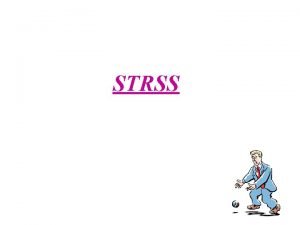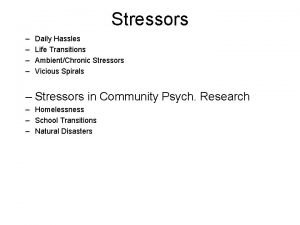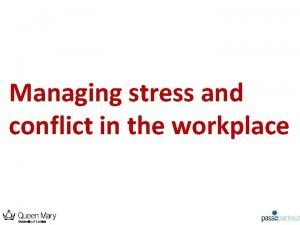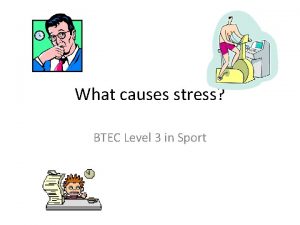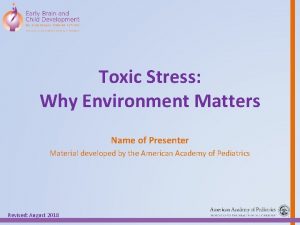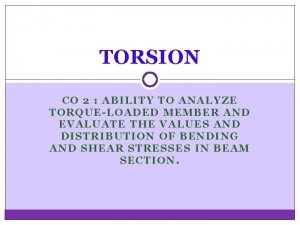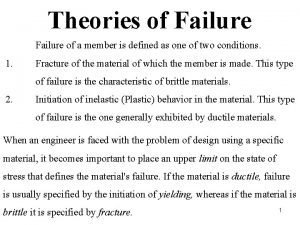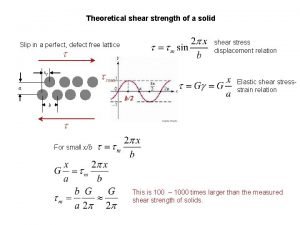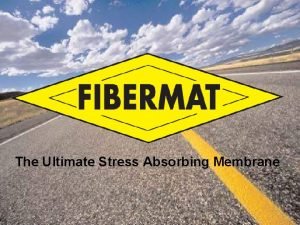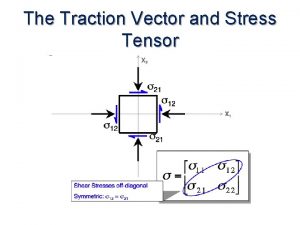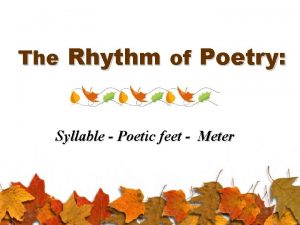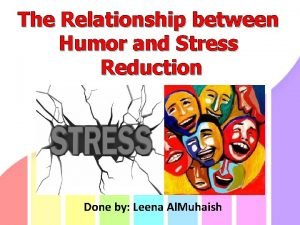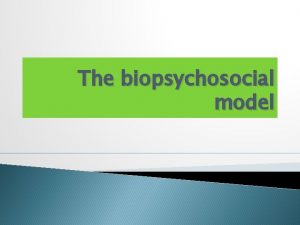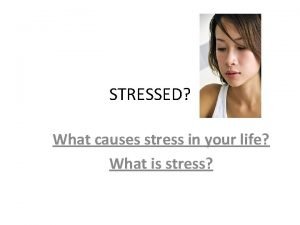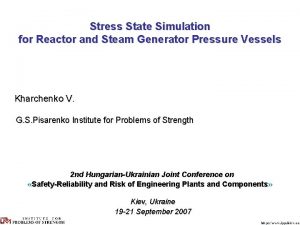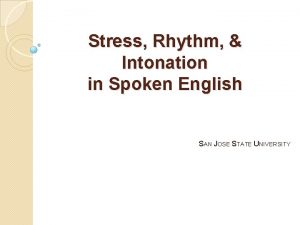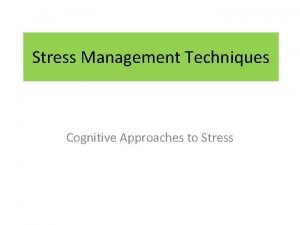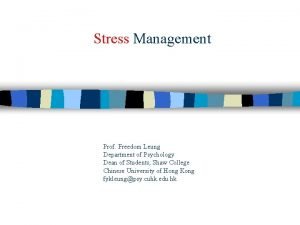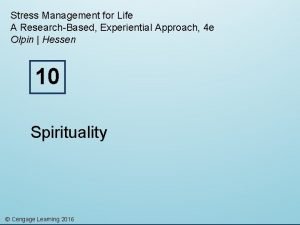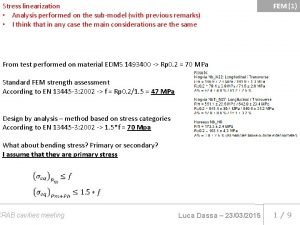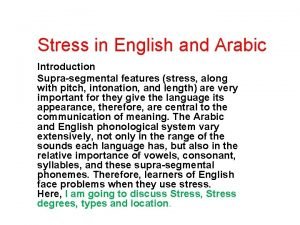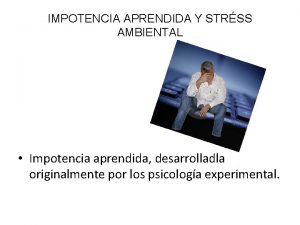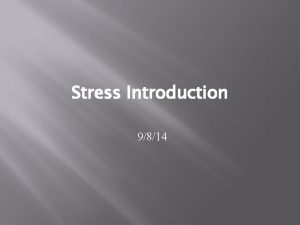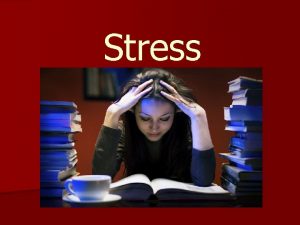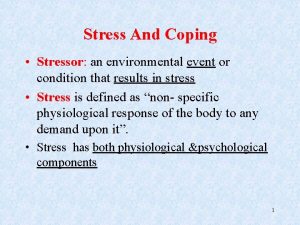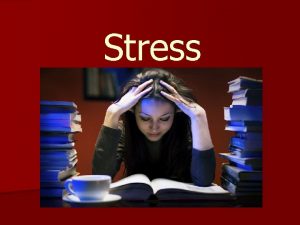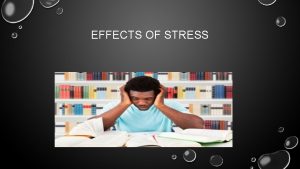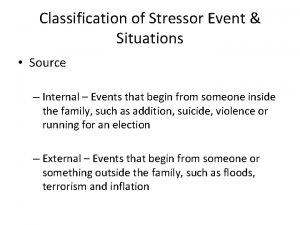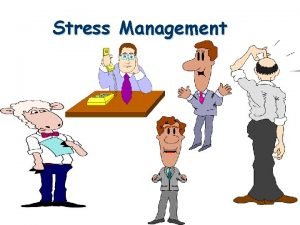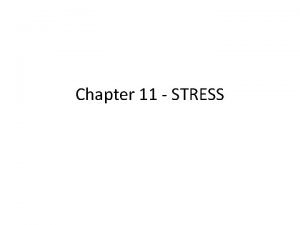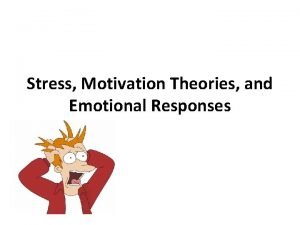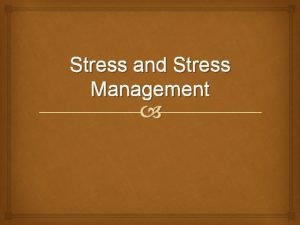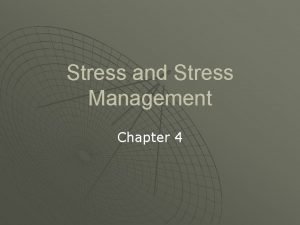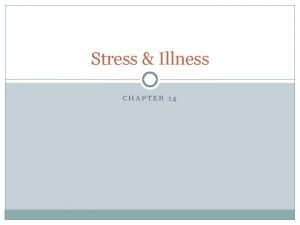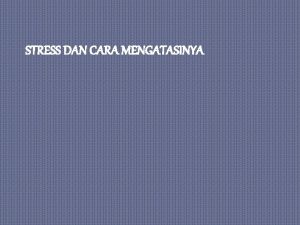STRSS Introduction n Stressor n Classification of stress








![[Neuroendocrine responses to stress] Neuroendocrine responses Locus ceruleus (LC) - norepinephrine neurons(NE)sympathetic/adrenal medulla axis [Neuroendocrine responses to stress] Neuroendocrine responses Locus ceruleus (LC) - norepinephrine neurons(NE)sympathetic/adrenal medulla axis](https://slidetodoc.com/presentation_image_h/2557b872ffb6e42afc8754238d6f48f1/image-9.jpg)

![[Neuroendocrine responses to stress] Neuroendocrine responses Locus ceruleus (LC) - norepinephrine neurons(NE)sympathetic/adrenal medulla axis [Neuroendocrine responses to stress] Neuroendocrine responses Locus ceruleus (LC) - norepinephrine neurons(NE)sympathetic/adrenal medulla axis](https://slidetodoc.com/presentation_image_h/2557b872ffb6e42afc8754238d6f48f1/image-11.jpg)









![[General adaptation syndrome, GAS] Certain changes take place within the body during stress that [General adaptation syndrome, GAS] Certain changes take place within the body during stress that](https://slidetodoc.com/presentation_image_h/2557b872ffb6e42afc8754238d6f48f1/image-21.jpg)
![[Acute phase proteins] 【Acute phase response】 The acute phase response is a quickly mobilized, [Acute phase proteins] 【Acute phase response】 The acute phase response is a quickly mobilized,](https://slidetodoc.com/presentation_image_h/2557b872ffb6e42afc8754238d6f48f1/image-22.jpg)













![[Stress ulcer] 1.Concept Stress ulcer is the term given to mucosal damage or lesions [Stress ulcer] 1.Concept Stress ulcer is the term given to mucosal damage or lesions](https://slidetodoc.com/presentation_image_h/2557b872ffb6e42afc8754238d6f48f1/image-36.jpg)
![[Essential hypertension] sympathetic - adrenal medulla excite Stressor Hypothalamus Emotion Noises Exertion Tension Sympathetic [Essential hypertension] sympathetic - adrenal medulla excite Stressor Hypothalamus Emotion Noises Exertion Tension Sympathetic](https://slidetodoc.com/presentation_image_h/2557b872ffb6e42afc8754238d6f48f1/image-37.jpg)

- Slides: 38

STRSS


Introduction n Stressor n Classification of stress response n Significance of stress

1.Stress is defined as a state of tension that can lead to disharmony or threaten the homeostasis of body. Necrosis burn operation infection Specific response stimulate hypoxia fester acidosis injury noise nonspecific and common response Increased heart rate Redistributio n of blood fe a r anxiety Stress not directly related to the nature of stimulus

2.Stressor The same stimuli, the same response? The stimuli or agents that induce stress are termed stressor. External environment(Physical, chemical, biological) Stressor Cold, heat, toxins, drugs, bacteria. Intrinsic factor of body Homeostasis, Acid-base disturbances, shock, cancer. Psychological or socio-cultural Threat to self esteem, relationships with other people.

3.Classification of stress response Physical, chemical Stress response Psychological stress Physical stress Psychological or socio-cultural 4.Significance of stress ■ Eustress: Normal stress is necessary for an active, healthy life, increase mental and physical alertness and can enhance certain abilities. (Fight or flight). Distress: if the stress response is excessive or prolonged, it may eventually result in diseases, such as ulcers, et al. ■

Stress response and pathogenesis stressor neuroendocrine response Cellular stress Effects of stress on the body

1. neuroendocrine response Nervous System Endocrine System
![Neuroendocrine responses to stress Neuroendocrine responses Locus ceruleus LC norepinephrine neuronsNEsympatheticadrenal medulla axis [Neuroendocrine responses to stress] Neuroendocrine responses Locus ceruleus (LC) - norepinephrine neurons(NE)sympathetic/adrenal medulla axis](https://slidetodoc.com/presentation_image_h/2557b872ffb6e42afc8754238d6f48f1/image-9.jpg)
[Neuroendocrine responses to stress] Neuroendocrine responses Locus ceruleus (LC) - norepinephrine neurons(NE)sympathetic/adrenal medulla axis (LC-NE)excitatory hypothalmus-pituitary-adrenal axis (HPA) excitatory Other hormonal responses to stress

Zona glomerulosa Zona fasciculata Adrenal cortex Zona reticularis adrenal medulla
![Neuroendocrine responses to stress Neuroendocrine responses Locus ceruleus LC norepinephrine neuronsNEsympatheticadrenal medulla axis [Neuroendocrine responses to stress] Neuroendocrine responses Locus ceruleus (LC) - norepinephrine neurons(NE)sympathetic/adrenal medulla axis](https://slidetodoc.com/presentation_image_h/2557b872ffb6e42afc8754238d6f48f1/image-11.jpg)
[Neuroendocrine responses to stress] Neuroendocrine responses Locus ceruleus (LC) - norepinephrine neurons(NE)sympathetic/adrenal medulla axis (LC-NE)excitatory Catecholamine (CA) secretion↑ hypothalmus-pituitary-adrenal axis (HPA) excitatory Glucocorticoid (GC) secretion↑ Other hormonal responses to stress

Locus ceruleus - Norepinephrine (LC-NE) 1. LC-NE Composition Psychological stress Cortex Emotio. Limbic system nal reaction PVN Physical stress CRH Pituitary adrenal medulla ACTH adrenal cotex GC CA

2. Effects of CNS ■ induce excitement, alertness, anxiety and other emotional reactions ■ rapid response system while stress occurs the key to start the HPA stress axis 3. Effects of peripheral ■ CA (include Ad、NE、Dopamine) concentration increase Plasma CA increase stimuli NE cold, hypoxia 10-20 fold Hemorrhagic shock 50 fold execution 45 fold Epinephrine 4-5 fold 10 fold 6 fold

4. Functional and metabolic responses of CA in body (1) compensatory significance ■ cardiovascular stress system CA↑ Heart rate↑, myocardial contractility↑, cardiac output ↑ peripheral resistance↑ ■ respiratory stress redistribution of blood flow system increased respiration↑ oxygen supply ↑

■Material stress energy metabolism CA↑ receptor in A cells(+) glucagon↑ receptor in B cells (+) insulin↓ blood glucose↑ glycogenolysis, lipolysis ↑ Meet the energy needs of the body n other hormones secretion increased secretion of ACTH, GH, EPO, T 3T 4 and renin

(2) Negative aspects of the body ■ continued contraction of Type A abdominal organs vessels ↓ gastrointestinal mucosal erosion and bleeding ■ vasoconstriction and heart rate↑ ■ increased energy consumption ■CA↑ thrombosis essential hypertension

Hypothalamic-pituitary-adrenal,HPA 1. HPA Composition HPA is composed of PVN、 anterior pituitary and adrenal cortex. Hippocampus, amygdala , Limbic system PVN LC-NE pituitary ACTH↑ Adrenal cortex GC↑ Physical stress Emotional reaction CRH↑

2. Effects of CNS Limbic system amygdala Physical stress PVN ② CRH↑ ③ β-EP↑ ① pituit ary ADH↑ CA ACTH↑ Adrenal cortex sympathetic - adrenal medulla excite GC↑ 3. Effects of peripheral moderate CRH↑ ● adaption excess CRH ↑ adaption disorder ● excited, memory enhancement anxiety, depression, loss of appetite

4. physiological significance of increased GC (GC↑>25 -37 mg/d) compensatory significance Negative aspects increase protein catabolism ● Suppression increase mobilization of fatty ● of immune response; Growth retardation; ● behavior change Gonadal axis suppression, ● ● acids from adipose tissue ● permissive action: enhancement of thyroid axis suppression the arteriolar response to CA ● stable lysosomal membrane stability ● anti-inflammatory ● abnormal behavior ● excessive protein breakdown, negative nitrogen balance

Stress other hormonal responses to stress hormone secretion site change -Endorphine anterior pituitary increase ADH hypothalamus increase Ald Adrenal cortex increase Glucagons cells increase Prolactin anterior pituitary increase Growth hormone Insulin anterior pituitary βcells acute↑, chronic↓ decrease TRH hypothalamus decrease TSH anterior pituitary decrease T 3, T 4 Thyroid decrease Gh. RH hypothalamus decrease
![General adaptation syndrome GAS Certain changes take place within the body during stress that [General adaptation syndrome, GAS] Certain changes take place within the body during stress that](https://slidetodoc.com/presentation_image_h/2557b872ffb6e42afc8754238d6f48f1/image-21.jpg)
[General adaptation syndrome, GAS] Certain changes take place within the body during stress that disrupt normal physiologic mechanisms and trigger an array of diseases. Characteristic Alarm stage Resistance stage Exhaustion stage rapid response , short duration sympathetic - adrenal medulla excite CA decline and GC increase Response becomes general again and signs of alarm reaction reappear. Adrenocortical hormones in the blood rises once more. Significance General mobilization of all the body’s defenses Body has adapted to the stessor and resistance is above normal Body’s resources are completely exhausted and death occurs.
![Acute phase proteins Acute phase response The acute phase response is a quickly mobilized [Acute phase proteins] 【Acute phase response】 The acute phase response is a quickly mobilized,](https://slidetodoc.com/presentation_image_h/2557b872ffb6e42afc8754238d6f48f1/image-22.jpg)
[Acute phase proteins] 【Acute phase response】 The acute phase response is a quickly mobilized, non-specific defensive response elicited in response of the host to infection, tissue injury or inflammation, etc. . 【Acute phase proteins, APP】 APP have been defined as one whose plasma concentration increases (positive acute phase proteins) or decreases (negative acute phase proteins) during the acute phase responses.

Stress 1. Origin of APP is synthesized by the liver, VEC, Mo, fibroblasts。 2.Classification of APP ■ Protease inhibitor protein ■ Related proteins of coagulation and fibrinolysis ■ Complement components↑ ■ Transporter protein↑ ■ other proteins

3.Function of APP Inhibition of protease activation:reduce tissue injury ■ Remove foreign bodies and necrotic tissue ■ Inhibit free radical production ■ Other functions ■

Ⅲ. Cellular responses to stress In responses of cellular-molecular level to more stressors (mai- nly non-psychogenic stressors), cell arouse a series of intracellu- lar signal transduction and activation of correlative gene and syn- thesize some protective protein, which mainly are heat shock pro- tein and acute phase protein.

Heat shock protein(HSP) 【Concept of HSP】 HSP are a class of functionally related proteins whose expression is increased when cells are exposed to elevated temperatures or other stress. This increase in expression is transcriptionally regulated. 【The biological characteristics of HSP 】 n. Non-specific inducement ■Widespread ■ Housekeeping

1. Factor of induced HSP production ldifferent kinds of environmental stress conditions: infection, inflammation, exercise, exposure of the cell to toxins (ethanol, arsenic, trace metals and ultraviolet light), l. Others: starvation, hypoxia (oxygen deprivation), nitrogen deficiency (in plants), or water deprivation.

2.Classification of HSP apparent molecular weight HSP 110, HSP 90, HSP 70, HSP 60 and small molecule HSP.

3.Function of HSP B Heat shock proteins function as intra-cellular chaperones for other proteins. They play an important role in protein interactions such as folding and assisting in the establishment of proper protein conformation (shape) and prevention of unwanted protein aggregation. By helping to stabilize partially unfolded proteins, HSPs aid in transporting proteins across membranes within the cell。

S H S P H ubiquitin S H P P P

Stress Effects of stress on the body

1. Effects on metabolism ■ High metabolic rate stress CA、GC↑ Catabolism↑ Weight loss, weakness, decreased resistance↓ ■ Changes in glucose metabolism stress insulin↓, CA、GH、GC↑ Glycogenolysis ↑ ■ Changes in fat metabolism ■ Changes in protein metabolism stress hyperglycemia

2. Effects of stress on the organs and systems ■Change of CNS LC-NE axis activation caused excitement, nervousness, ▲ anxiety, fear, anger, etc. 。 ▲ HPA axis moderate activation caused excitement, proper mood and learning ability ▲ HPA axis excess activation caused CNS dysfunction, depression, anorexia, and even suicidal. ■Change of cardiovascular system ■Change of gastrointestinal

■Change ▲Acute of immunity stress response stress number of peripheral blood phagocytic cells↑,APs↑ receptors in Mф、TC、BC GC、CA↑ binding immunity function↓ ■Change of blood WBC, Plt↑, Blood coagulation ↑, viscosity ↑, ESR↑thrombosis ■Change of kidney and procreation

Stress and disease
![Stress ulcer 1Concept Stress ulcer is the term given to mucosal damage or lesions [Stress ulcer] 1.Concept Stress ulcer is the term given to mucosal damage or lesions](https://slidetodoc.com/presentation_image_h/2557b872ffb6e42afc8754238d6f48f1/image-36.jpg)
[Stress ulcer] 1.Concept Stress ulcer is the term given to mucosal damage or lesions of the stomach or duodenum in critically ill or stress- ed otherwise healthy patients. 2.Mechanisms ■ mucosal ischemia ■ increased ■ other GC secretion factors ▲ acidosis ▲ bile acid and lysolecithin This patient with no Helicobacter infection got this ulcer during a period of severe somatic stress due to a heart disease.
![Essential hypertension sympathetic adrenal medulla excite Stressor Hypothalamus Emotion Noises Exertion Tension Sympathetic [Essential hypertension] sympathetic - adrenal medulla excite Stressor Hypothalamus Emotion Noises Exertion Tension Sympathetic](https://slidetodoc.com/presentation_image_h/2557b872ffb6e42afc8754238d6f48f1/image-37.jpg)
[Essential hypertension] sympathetic - adrenal medulla excite Stressor Hypothalamus Emotion Noises Exertion Tension Sympathetic impulse↑ Renin ↑ Adrenal catecholamines↑ Vasoconstriction Hypertension Ald ↑ Angiotensin Ⅱ ↑ Retention of water and sodium Elevated arterial pressure

Thanks for attention !
 Strss
Strss Types of stressor
Types of stressor Stressors
Stressors True stress and engineering stress
True stress and engineering stress Definition of axial stress
Definition of axial stress Chapter 10 stress responses and stress management
Chapter 10 stress responses and stress management Stress and conflict introduction
Stress and conflict introduction Eager learning examples
Eager learning examples Qualitative classification in statistics
Qualitative classification in statistics Traditional classification vs modern classification
Traditional classification vs modern classification Introduction of classification of computer
Introduction of classification of computer Conclusion paragraph format
Conclusion paragraph format Personal causes of stress in sport
Personal causes of stress in sport Phaneuf margot
Phaneuf margot Stress container
Stress container Define tolerable stress
Define tolerable stress Torsional shear stress formula
Torsional shear stress formula Distortion energy theory formula
Distortion energy theory formula Dislocation glide vs climb
Dislocation glide vs climb Fibermat
Fibermat Traction vector on a plane
Traction vector on a plane Feet and meter in poetry
Feet and meter in poetry Reduce stress
Reduce stress Manitoba teachers society long term disability
Manitoba teachers society long term disability Diathesis-stress model psychology example
Diathesis-stress model psychology example Stress sårbarhedsmodellen
Stress sårbarhedsmodellen Mark the stress in following words
Mark the stress in following words Holmes rahe stress test
Holmes rahe stress test Sentence stress generator
Sentence stress generator Contrastive stress
Contrastive stress Fatigueed
Fatigueed Cognitive stress management techniques
Cognitive stress management techniques Stress portrait of a killer summary
Stress portrait of a killer summary Stress management learning objectives
Stress management learning objectives Stress management for life
Stress management for life Paragraph on stress management
Paragraph on stress management Life skills stress management
Life skills stress management Stress linearization
Stress linearization Stress in arabic
Stress in arabic
